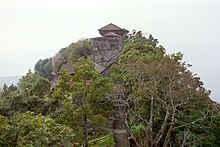Kingdom of Gorkha
Kingdom of Gorkha ( Devanagari : गोर्खा राज्य Gorkhā Rājya ) was the official name for today's Nepal until the beginning of the 20th century . The empire emerged from the principality of Gorkha, which belonged to the Chaubisi Rajya (24 principalities) in western Nepal. The principality lay between the rivers Marsyangdi and Trishuli and corresponds roughly to the area of today 's Gorkha district . The inhabitants of the country called themselves Gorkhali.
expansion

In the 16th century, Gorkha, a principality of the Magar people , came under the rule of the Shah dynasity when Dravya Shah (1559–1570) came to power. The ancestors of the Shahs, Sisodia- Rajputs from Chittorgadh in what is now Rajasthan , had found refuge from the Arab invaders in Gorkha.
There were around 50 small principalities on the territory of Nepal, some of which were united in various alliances. From the middle of the 18th century, Gorkha began under Prithvi Narayan Shah with the annexation of adjacent principalities, beginning with Nuwakot and then the three kingdoms in the Kathmandu valley (1768–1769). The name of the Newari Nepal was common for the Kathmandu valley . Narayan moved his capital to Kathmandu . Until his death in 1775, the Sen kingdoms of Chaudandi and Vijaypur, located further to the east, were added. His successors continued the policy of annexation. At its greatest expansion in the early 19th century, the kingdom stretched from Kumaon and Gadwal ( Uttarakhand , northern India) in the west to Sikkim in the east. Attempts to conquer parts of Tibet failed. The expansion efforts were finally ended after the defeat in the Gurkha War (1814-1816), due to which Gorkha even had to cede areas.
Gorkha / Nepal
The term Gorkha Rajya (Kingdom of Gorkha) was still common until the beginning of the 20th century; analogously, the name Gorkhali was used for the language . The official renaming in Nepal or Nepali took place in the 1920s and 1930s. However, the oldest national newspaper in Nepal, Gorkhapatra, has kept its old name.
Individual evidence
- ^ Francis Buchanan Hamilton: An Account of the Kingdom Of Nepal and of the Territories Annexed to This Dominion by the House of Gorkha . Longman, Edinburgh 1819, p. 237 .
- ^ Colonel Kirkpatrick: An Account of the Kingdom of Nepaul . William Miller, London 1811, p. 123 .
- ↑ Don Messerschmidt: Bringing Aid To Gorkha's Poor. (No longer available online.) In: ECS Nepal. April 2010, archived from the original on December 15, 2012 ; Retrieved January 11, 2013 . Info: The archive link was inserted automatically and has not yet been checked. Please check the original and archive link according to the instructions and then remove this notice.
- ^ Francis Buchanan Hamilton: An Account of the Kingdom Of Nepal and of the Territories Annexed to This Dominion by the House of Gorkha . Longman, Edinburgh 1819, p. 7 .
- ^ William Brook Northey, Charles John Morris: The Gurkhas: Nepal-Their Manners, Customs and Country. London 1928. (Reprint: Asian Educational Services, New Delhi 2001, ISBN 81-206-1577-8 , pp. 30–31)
- ^ Pranab Kumar Jha: History of Sikkim, 1817-1904: Analysis of British Policy and Activities . OPS Publishers, 1985, pp. 11 .
- ^ Francis Buchanan Hamilton: An Account of the Kingdom Of Nepal and of the Territories Annexed to This Dominion by the House of Gorkha . Longman, Edinburgh 1819, p. 7 .
- ^ Siegfried Lienhard: Songs of Nepal: An Anthology of Nevar Folksongs and Hymns. Motilal Banarsidas, New Delhi 1992, ISBN 81-208-0963-7 , p. 3.

